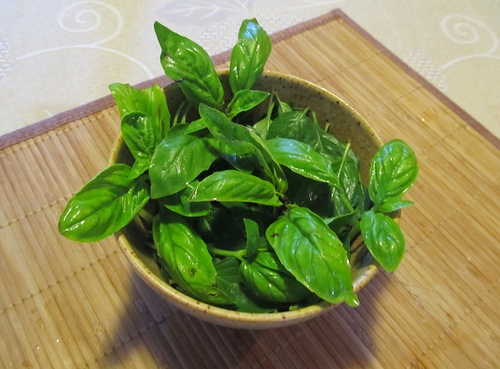
Basil consists of about 150 species worldwide and belongs to the family of the Labiatae. The most well known basil is sweet basil (Ocimum basilicum).
Some of the many varieties of basil include:
- Sweet basil (Coffet Astoria Dynamic Ocimum basilicum)
- French fine leaf basil (Coffet Asta Dynamic basilicum minimum var.)
- Lettuce leaf basil (Tobacco Marquise Bland Ocimum basilicum crispun)
- Dark opal basil (Pomme de terre rouge purpurascens var)
- Lemon basil (Coffret Chocolat Aigubelle Dynamic Ocimum americanum: Ocimum canun x Ocimum b.v. purpurascens)
- Camphor basil (Ocimum kilimandscharicum)
- Licorice basil (Ocimum basilicum var. "PC")
- Cinnamon basil (Ocimum basilicum cv. "cinnamon")
- Bush basil (Ocimum basilicum minimum)
- "Tulasi" holy basil (Ocimum sanctum)
- Genovese basil (Ocimum basilicum var. "SNES")
- Thrysiflora basil (Ocimum basilicum var. "Saga")
Description[edit | edit source]
Basil grows in a bushy way, with soft, large and light green or deep purple leaves. The leaves tend to be oval in shape. The leaves are pungent and have a fresh flavour.
Basil flowers during summer and has small, delicate pink or white flowers.
Growing sweet basil[edit | edit source]
The most common form of basil is sweet basil and the one you're most likely to grow as part of a kitchen garden or herb garden.
Decide whether you want to grow it from seed (the seeds germinate in about two to three days) or from cuttings taken from firm wood stems of existing basil plants. If using seed, be aware that sweet basil seeds can remain viable for several years if stored in a cool, dry place away from direct light.
To plant, use well-drained soil in a warm and sunny position. Push the seeds firmly into the ground and expect fast growth. If grown in a cooler climate, sow the seeds indoors first, then transplant to the garden when it becomes warmer. If you choose to keep growing them indoors, grow in a sunny, warm position.
As the plant grows, it's a good idea to pinch out the first flower-heads to encourage production of more leaves for use.
Harvesting basil[edit | edit source]
To keep basil producing more wonderful leaves for your cuisine, snip off the blooms regularly. Make this a part of the harvesting schedule. The first harvest should be possible around four to six weeks after transplanting or six to eight weeks after sowing seeds. Prune when harvesting to remove the blooms and you should get successive harvests every few weeks.
Pick the larger leaves first, allowing the smaller leaves a chance to grow bigger.
The best part of the basil plant is found at its top. The four leaves right at the top are the choicest. Even better, don't be afraid to remove it when it's ready as this will motivate the plant to produce more!
The best time to harvest is just after the dew of the morning has dried and before the day's heat commences.
Note! Basil bruises very easily and once this happens, it oxidises and therefore turns black. While it is still perfectly edible, it's not that pretty to look at. To avoid bruising when harvesting, don't crush leaves with your fingers and pile the basil into a large container, loosely.
Growing in winter[edit | edit source]
In a mild climate, (e.g. Sydney or Perth in Australia, or the southern United States) basil can be grown over winter, if given a sheltered location. Basil may even be made to survive another year if cut back very hard (removing almost the entire bush) to prevent going to seed. This might need to be performed multiple times, especially removing any buds and flowers that manage to form.
Basil may be grown in winter in colder climates by growing in a pot which is moved indoors, preferably near a sunny window, or into a greenhouse.
Cooking with basil[edit | edit source]
Basil is widely used in the cuisine of:
- Europe, especially Italy
- Asia, notably Thailand; other varieties are grown such as lemon basil in Indonesia (kemangi) and varieties known as "holy basil" in Thailand (krapow) and India.
Common Italian basil use includes pesto (a basil sauce or paste), pizza topping, pasta sauce addition and atop bruschetta.
Preserving basil[edit | edit source]
Preserving basil depends on what you want to use it for later and the preserving methods open to you. The main methods are:
- Drying: whole leaves, flowers, seeds (seeds can be saved to sow again or to add to salads, dressings, etc.)
- Salting: whole leaves
- Liquid options: vinegar, oil, alcohol, water (freezing), jellies
- Pastes: oil, butter, pesto, ice cubes.
If you'd like to freeze basil: Pick fresh leaves. Clean and dry them as needed. Lay the leaves out on a biscuit (cookie) tray (sheet). Place in the freezer. Allow to freeze. Remove from the freezer. Pack the frozen leaves into a small resealable bag. Return to the freezer. The texture will be destroyed but the flavour remains. It is superior in flavour to dried basil.
Basil in other languages[edit | edit source]
Here are some common ways to say basil in other languages:
- Italian: basilico
- French: basilic commun
- Greek: vasiliko
- Thai: ka prou
- Spanish: albahaca